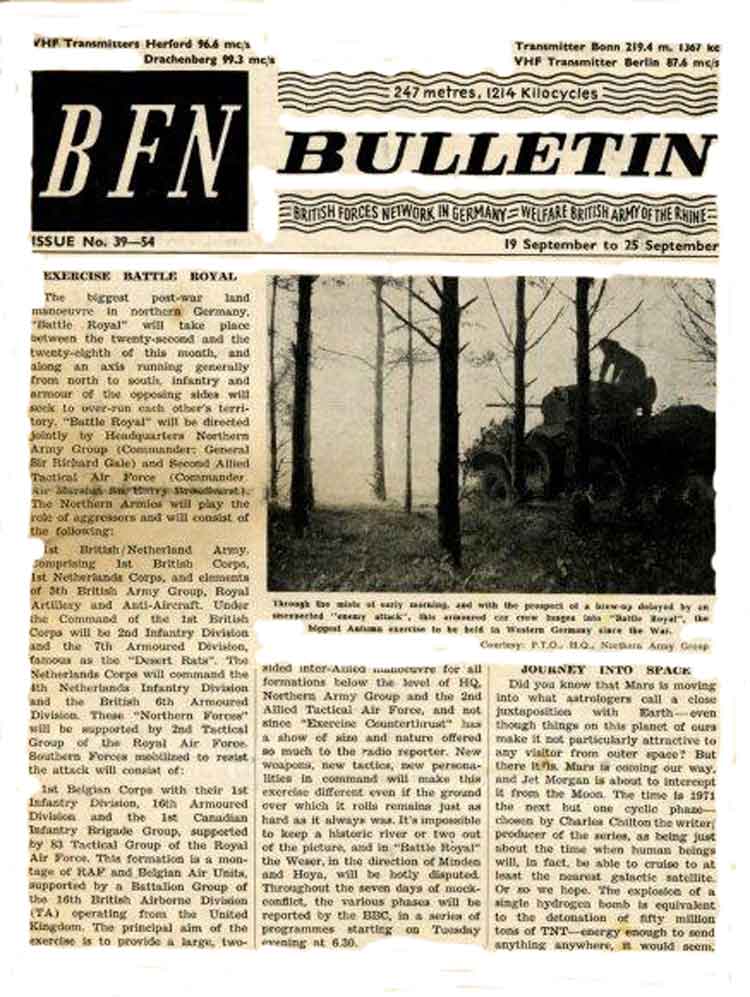
|
||
|
British Forces Network Bulletin dated 19Sep54 reporting on the up and coming Exercise Battle Royal and a new broadcast programme set in the future - 1971!- when they forecasted that man will be able to cruise in space. (Thanks to Dinger Bell.) Exercise Battle Royal. NATO's principal exercise for 1954, Exercise Battle Royal, was held between 22nd and 28th September and was quickly dubbed the biggest military manoeuvres in Northern Germany since the end of the war. The principal aim of the exercise was to examine the implications of the tactical employment of atomic missiles on the battlefield and to look at ways of increasing the mobility of ground fighting units; throughout the exercise close support of the land forces would be provided by the Allied air forces. New Army tactics of quick concentration, attack and dispersal placed great reliance on the responsiveness of the air arms and reconnaissance remained of supreme importance. Due to the large influx of pilots over the preceding year it was essential to keep disruption of routine training to the minimum and as a result most of 2TAF's aircraft were not deployed to operate under field conditions as had been the case in almost all major exercises up to this point. Forces operating under the 'Southland' banner for Exercise Battle Royal were located at Bruggen, Wildenrath and Geilen-kirchen (Sabre day fighters), Nörvenich (Venom ground-attack fighters), Gutersloh (Meteor FR9 and Belgian RF-84F Thunderflash tactical reconnaissance) and Wahn (Meteor NF11 night fighters). 'Northland'. on the other hand, had Venom fighter/ ground-attack wings based at Fassberg and Wunstorf with tactical reconnaissance Meteor FR9s of the RAF, Dutch RF-84Fs and RAF Meteor NF11 night fighters based at Ahlhorn. Photographic reconnaissance assets (Meteor PR10s) at Gutersloh were to be shared between 'Northland' and `Southland' whilst four Douglas RB-26 Invaders of the USAF's 1st Tactical Reconnaissance Squadron from Spangdahlem were deployed to Gutersloh to conduct night photographic reconnaissance. Extensive ground operations were also planned, including laying a pierced-steel-planking (PSP) runway at Achmer and deploying a mobile field hospital from Rostrop to woods at Heek, near Bruggen. Battle Royal was also to be the proving ground for new concepts in air reconnaissance. No 2 Squadron operating the Meteor FR9 in the tactical reconnaissance role began to favour tasking single aircraft for missions, rather than the two which had been the norm since the war; however, its sister squadron, No 79, continued to prefer the use of two aircraft for each task. New equipment for photographic processing and interpretation was also introduced during Exercise Battle Royal, located in a new Mobile Field Photographic Section (MFPS) which was based on a convoy of some 40 vehicles. The increased pace of the land battle demanded better photographic processing and interpretation facilities if the results were to be of any value to commanders on the ground. Venoms from Nos 16, 94 and 145 Squadrons deployed to Nörvenich, to operate from tented sites on the new and barely complete airfield. Unfortunately, poor weather thwarted many of the planned elements of the exercise although that in itself provided a valuable lesson - how could the reconnaissance task be continued in poor weather? The vulnerability of the Meteor PR 10 to attack by swept-wing fighters such as the F-86D Sabre of FOURATAF drove it down to low-level operations for the first time, although the aircraft was not comfortable or easy to fly in such a role. Experiments were also carried out with a Meteor drop tank converted to drop photo-flash flares to give 541 Squadron a night low-level capability. (Thanks to Bill Taylor's excellent book "Royal Air Force Germany since 1945"). |
||